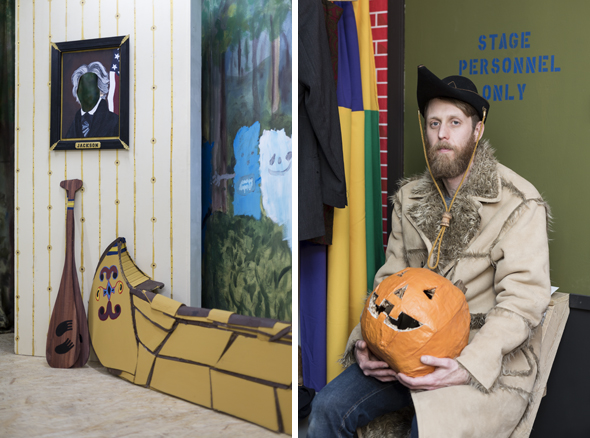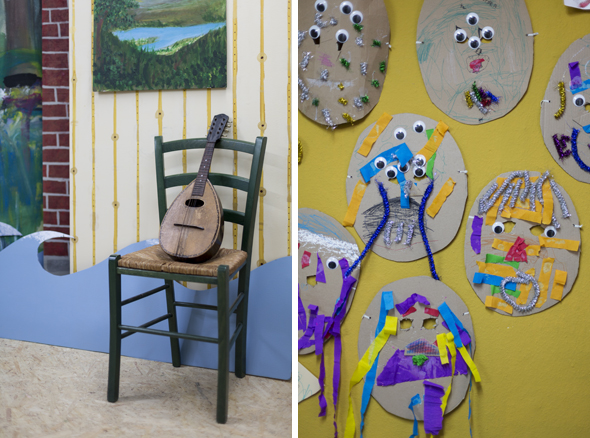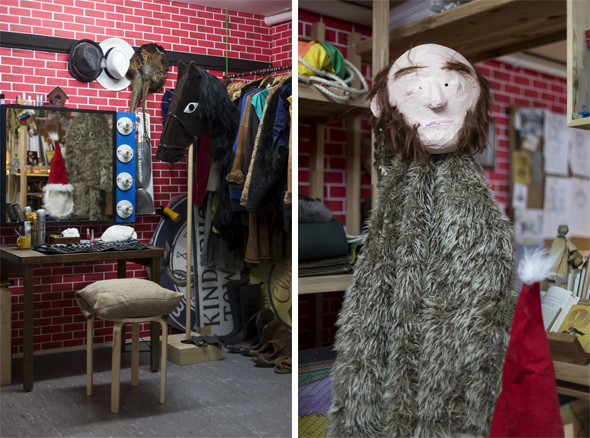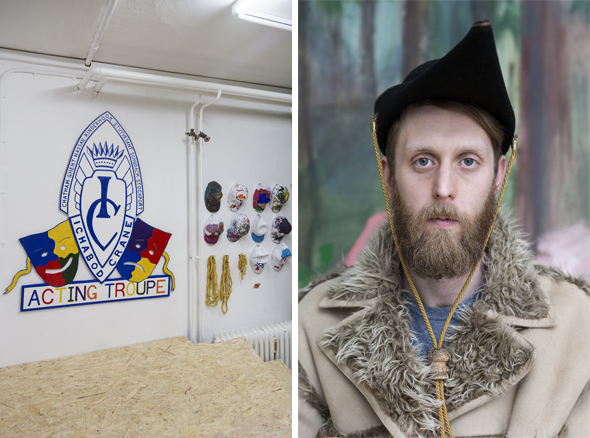Christopher Kline is co-owner, with his partner Sol Calero, of Kreuzberg project space Kinderhook & Caracas. The gallery’s name refers to the founders’ hometowns, in New York and Venezuela respectively. Kinderhook, NY also forms the basis of Kline’s ongoing theatrical venture O.K. – The Musical, which was first performed at Grimmuseum last year and will see its next manifestation this Thursday evening at KW Institute for Contemporary Art. Kline has been in residence at insitu for the last month, where he’s been conducting community workshops to build the sets and storyline for his production. Berlin Art Link entered the fray – amidst a handful of dedicated volunteers – to discuss the process of creating a musical based on one town’s local history.
Alison Hugill: O.K. – the Musical is a social project based on your hometown, and is conducted through the community theatre genre. How does it work in this context, to create a community theatre-style musical outside of the town where it’s set?
 Christopher Kline at insitu, Berlin; Photos © Maike Wagner
Christopher Kline at insitu, Berlin; Photos © Maike Wagner
Christopher Kline: The overall project is more one of local history research. When I started working on it, I had a couple exhibitions related to the theme. I was trying to work with a regional style – like knitting or quilting, or traditional basket-making techniques from the region – but there weren’t a lot of aesthetically relevant themes for the show, without putting too much of my own aesthetic into it. There’s a lot of musical theatre in Kinderhook so it seemed like a good way to synthesize the local history in a way that people would get.
AH: Why is it important for them to understand your work, given that you’re based in Berlin and presenting it in Berlin?
CK: The more people that are engaged there, the more accurate it will be. Yet at the same time, with local histories, you have a lot of inaccuracies because of the censorship that often goes into it. There are a few things that I included in my first research booklet that people had asked me to take out. And that happened while I am working here. I can only imagine what local historians have to deal with.
The more people that are involved, the better, because it’s not simply about my view. In many ways, the project is about everybody’s tenuous connections to historical events.
AH: You try to bring out the unsavoury aspects of Kinderhook’s history as well – like colonialism and slavery.
CK: Local histories tend to be very superlative in their narratives: “Everyone here is really nice and that’s just how it’s been forever!” These histories are often sponsored, whereas my project is coming for a very different context. I like the place enough to do the project, yet I have enough distance to be critical. Right now I am picking and choosing things about Kinderhook’s history that are interesting to me, but eventually I’d like for it to be non-partisan. I’d like to get everyone’s picture of the town.
 Christopher Kline ‘Framework 5: O.K. the Musical’ at insitu, Berlin; Photo © Maike Wagner
Christopher Kline ‘Framework 5: O.K. the Musical’ at insitu, Berlin; Photo © Maike Wagner
AH: Is it crucial that the project is participatory?
CK: We have kids coming in from the Kita. It’s not so much about teaching about the history of Kinderhook in the workshops, but rather about making things with other people. That’s the way community theatre works – there are all kinds of visions and compromises and you have to just see how people want to participate. Eventually I would like to stage it in Kinderhook, but I’d like to develop it more first.
AH: How do you get the public involved in your process?
CK: The idea was to incorporate kids more. More than it ended up in fact because in order to really get things done with children, you need a lot of time and planning. This has been a learning curve but the kids came and painted things and designed things and acted. But as far as actually producing things for the musical, it didn’t quite work out as planned. With any social project, you have to give up a lot of expectations, because it’s not going to be what you think.
People have come together in different arrangements. Leanne MacKay is the Art Director, she’s designing the sets. They were painted by three people, and the kids from the Kita painted a bit on top of that. The Kita made rattles and we’re recording sounds for the backing effects. In the future I’d love to do a more extended project with older kids, in which they could learn the characters and act. For a Kita it’s more about having an adventure: they come to a strange place and they do things they don’t normally get to do.
We have a cast of 23 people, all volunteers. Elisabeth Wood is the Music Director. I composed the songs and she makes the arrangements. We have a ten-piece band with flutes, a French horn, trombone, saxophone. So there are all kinds of people involved, most of whom I had never met before. That’s also a nice part of the process of learning how to deal with a community. When you’re working as an artist, it can be solitary and a lot about being alone in your studio. Exhibitions become rhetorical exercises that mean very little to people outside the art world. This project is more about directing than being an artist. In that way, everyone can get due credit. Many artists have production teams and assistants that are not acknowledged. The nature of my project is different because it’s happening in a non-profit space, and it’s not a very marketable piece. If it was in a commercial space it would be totally different.
 Christopher Kline at insitu, Berlin; Photo © Maike Wagner
Christopher Kline at insitu, Berlin; Photo © Maike Wagner
AH: Is this kind of community-based work new to you? A lot of your other works seem to use textile as a medium.
CK: It’s sort of new to me. I used to work a lot in groups and do performances; I’ve been in bands. I’ve done theatre pieces before, but much more surreal.
I’ve worked a lot with textiles and craft practices in the past. They have a community reference but they are still very solitary works. I liked being in bands and collectives but as you get older they become much more frustrating, so you have to find new ways of collaborating where everyone can be happy. For me that exists in processes, like film, where there are defined roles. The person doing the costumes, for example, is just focusing on that, and they know their limits. Elisabeth, the Music Director, has a policy of inclusion for the choir she conducts. We didn’t do auditions.
AH: It’s kind of a curatorial project, which is familiar to you I guess.
CK: Yes, I run Kinderhook & Caracas with my wife Sol, who is in the back making costumes right now. Our production and our space is a very similar thing – we like to execute these kinds of ideas. You can push people a bit to make their exhibition happen, without your name on it. For us it’s not a clear line between producing our own art, helping to produce other people’s art, and producing projects that have a collaborative nature.
 Christopher Kline at insitu, Berlin; Photo © Maike Wagner
Christopher Kline at insitu, Berlin; Photo © Maike Wagner
AH: Can you talk a bit about the narrative behind your musical?
CK: The performance at KW is called O.K. – The Musical (Dress Rehearsals) because it’s an excerpt of a potentially full musical. There are five scenes, the first four are historical vignettes; scenes related to the history of Kinderhook. The last scene is like a Broadway finale spectacle, where all the characters appear. If I could make a film one day of the whole musical, it would be about a character who is making a musical and these scenes are in the movie. There would be a separation between a real life and a musical being put on by a community. That would involve a longer script. The scenes in this one have little dialogue, they are mostly sung. It’s partly the official history of the area, but with some tenuous links. The first scene is about Henry Hudson’s encounter with the Mohican Indians of the area. When i was researching I realized they can’t really prove that Hudson even came to that side of the river. There are signs that say “Henry Hudson landed here and named it Kinderhook.” But actually it’s probably not the case, as his journals reveal. The story we tell is based on some version of this unverifiable history. Every song has this element of doubt in it.
Additional Info
KW Institute for Contemporary Art
O.K. — The Musical (Dress Rehearsals) — ONE NIGHT STAND #4
Performance: Feb. 26, 2015; 7pm
Auguststraße 69 (click here for map)
Writer Info
Alison Hugill has a Master’s in Art Theory from Goldsmiths College, University of London (2011). Her research focuses on marxist-feminist politics and aesthetic theories of community, communication and communism. Alison is an editor, writer and curator based in Berlin.
alisonhugill.com



















